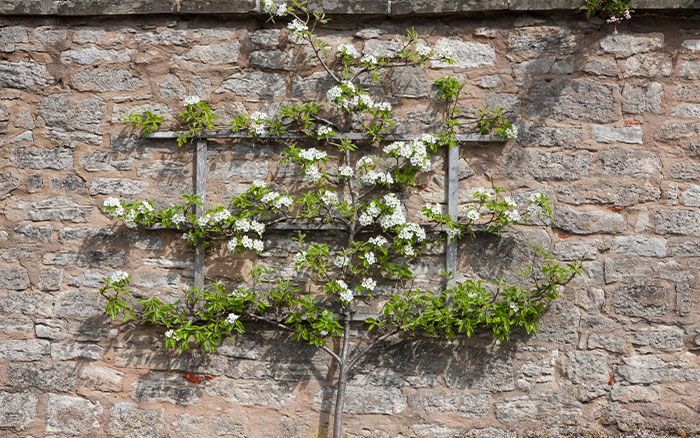For a fruitful garden, no matter how small your space, training fruit trees can create a pretty and practical feature.
Fruiting favourites
Trained fruit is a practical and purposeful way to being beauty in the garden. These ornamental ways of growing are versatile and have the ability to turn a garden wall into a green feature.
They will put on a show year-round with their beautiful leaves, autumnal colour, spring flowers, and of course fruit – so they are a big garden win.

Different fruits suit different styles of training. Espalier pears and apples look striking with their horizontal branches.
Alternatively, grow apples, pears, and plums as cordons with their leaning habit on walkways, arches, and walls, or fan trained trees have beautiful shape.
Training fruit trees give you a garden bounty whilst being a stunning and productive feature.
Cordon trees

Cordon fruit trees are trees grown as a single stem, with the fruit growing off short sideshoots. These trees can be trained upwards, but they are most commonly grown at a 45-degree angle because it means there are more fruits at perfect picking height.
Though they may give a smaller yield than a full-grown traditional tree, they can be planted between 60-90cm apart. So, if you have the floor space to spare, you can have a productive plot.
Plant cordon trees in winter, choosing a cordon tree with a suitable rootstock. They can be grown free-standing or against a wall or fence. When grown next to a wall or fence, taut horizontal wires are necessary to tie the stems to. Having the right support in place is important to keeping them growing best.
Prepare the area for planting by removing weeds, digging in plenty of well-rotted organic matter and positioning a bamboo cane in place to offer support and direction. Then, the trees can be planted, angled in the same direction as the bamboo cane. Tie the stem to the cane, before firming in the soil and watering in well.
Keep the fruit trees in good shape by getting the pruning right. In late summer, where sideshoots have grown, cut them back to three leaves. Then, the laterals on which the fruit grows can be cut back to one leaf.
Doing this whilst there is fruit on the tree kicks the tree into focusing its energy into producing new flowers the following year.
In winter, pruning damaged, dead, and diseased foliage as well as unproductive foliage is ideal. This opens up the structure to allow air circulation and boost the health of the plant.
Espalier trees
The horizontal branches from the central trunk of espalier trees have such a stunning effect against walls. Although, they are a great option for create a divide or a living wall when grown against wires or posts as support.
If you are planting more than one espalier tree, they should be planted between 3-6 metres apart. Cut back the main stem to 30cm tall, then allow the top three buds to grow out, training the top one vertically using a cane as support.

Begin training by tying in the canes at a 45-degree angle, then in November they can be lowered until they sit horizontally.
The main vertical stem can be cut back to 45cm of the lower stems, keeping two buds in place that will form the next horizontal tier. Repeat this until all of the horizontal layers have grown. When starting out, remove the spring blossom for the first three years of growth. This will force the energy into the plant growth instead.
Apple and pears can be trained as espalier trees, but blossom and ornamental plants such as Pyracantha can be trained this way too.
Fan trained trees

Another beautiful and productive method of training is fan-training. As the name suggests, they are formed by a short trunk from which straight branches grow to form a fan structure. This way allows the most light to reach the tree, making it the suitable way to grow sun-loving fruits.
Peaches, plums, cherries, apricots, and figs can be grown using this technique.
Get started by planting the tree around 15-23cm away from the wall, ensuring the wall is at least 2m tall, to allow the tree to fill the space.
To train and prune, it depends on the tree that you start with, if it has branches or not already. In the first spring, cut back he main stem to 40cm, with three strong buds or two main branches left in place.
Position two canes at 45-degree angle, tying the branches into place. In the second year cut back the branches by two thirds.
To form the fan shape, in summer pick four shoots from each of the branches – each at a position that when tied at a 30-degree angle the shape is fan-like. Remove any shoots that face towards the wall.
Next spring, cut each of the four branches back by one third. When new growth appears, tie in any new growth that extends the main branch framework.

Leave A Comment